NorthEast Radio Watch 12/23 & 12/30/2024: WKIT Lives!
In this week’s issue… WKIT finds a buyer - Eskin out at WIP - Staff shifts in Utica - CRTC approves Bell divestitures
Text and photos by SCOTT FYBUSH
How do we keep weekly Site of the Week segments coming to you as we get ever closer, in our recaps, to that moment when travel had to (mostly) stop for a year?
We show you some travels that might not have ordinarily made this column – but as every PSA on the radio told us for months, these are “unprecedented times,” right?
And thus we take you this week to our final trip of 2019, a quickie jaunt south to Washington, DC for a single, not-quite-broadcast purpose. We’d had plenty of opportunities on previous DC trips to visit the Newseum once it opened just off the National Mall in 2008, but something else always took priority, right up until the announcement that the massive Newseum building had been sold and would be closing on Dec. 31, 2019.
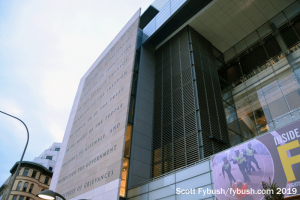

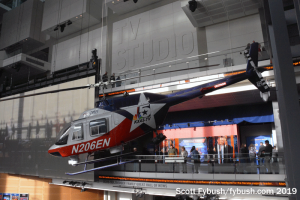

We’d been to the Newseum once before, at its much smaller initial site across the river in Rosslyn, Virginia, and we honestly hadn’t realized how much more there was to see in this huge new seven-level incarnation – including some fascinating artifacts that help tell the story of journalism and broadcasting, which makes it relevant for this page, right?
There was a massive atrium fronting on Pennsylvania Avenue, where the words of the First Amendment were carved in stone on the exterior of the building. Inside, visitors started out one floor below ground level, then went up an elevator to the top and worked their way back down.
Look up in the atrium and you saw a TV news helicopter, in this case from KXAS in Fort Worth, Texas. Go down to the entry level, and you might find yourself eating lunch next to the first satellite newsgathering van, on loan from the now-defunct CONUS service run by Hubbard out of Minnesota back in the 1980s and 1990s.
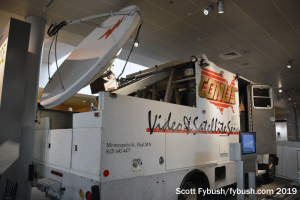

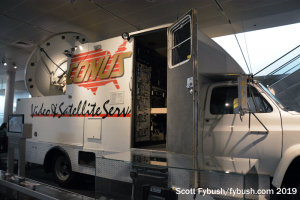

(This one brought back some intense memories, because when your editor was doing TV news in the late 1990s, it was at a Time Warner local news channel that depended heavily on CONUS for satellite services; it’s entirely possible that this very truck transmitted one of my stories at some point!)
Other displays down here included the Unabomber’s actual cabin, part of a larger exhibit on the FBI and journalism, but that’s a little beyond our Site of the Week focus here.
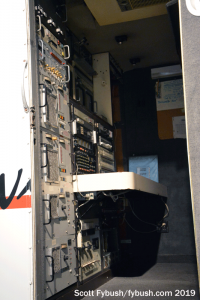

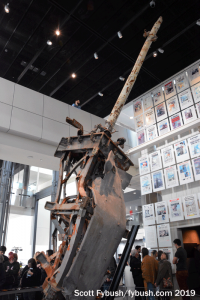

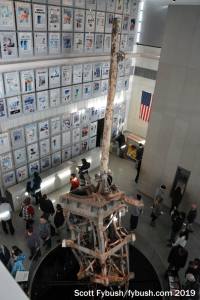

What’s not outside our focus was one of the most prominent exhibits in the Newseum. As you went up the elevator, you couldn’t miss the multi-story gallery that rose just off the main atrium: the 9/11 exhibit here included not only two walls of newspaper front pages from the attack and its aftermath but also the mangled wreckage of the TV antenna mast that rose from 1 World Trade Center.
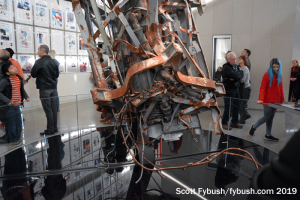

How many engineers did I know whose work went into those antennas and transmission lines?
For any of us who lived through those terrible days, it’s hard to look at the remnants of this mast that once rose 1400 feet above lower Manhattan with dry eyes.
(There was also a large segment of the Berlin Wall nearby here, as well as other 9/11 artifacts – but how could you take your eyes off the wreckage of that antenna?)
Ascending to the top levels of the museum, there were several temporary exhibits, a long corridor of printouts of that day’s front pages from around the world (which has long been a popular online Newseum feature, and which continues even now as a project of its parent, the Freedom Foundation.)
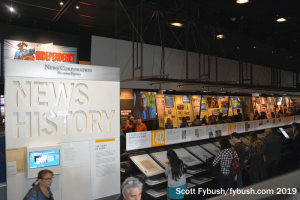

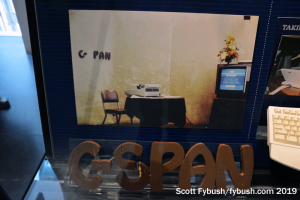

Drop down a level and you’re in a long gallery displaying the history of news over the past five centuries.


You could (and I did) spend hours with the pull-out trays in the center of the gallery, holding actual front pages of newspapers and magazines chronicling major world events, and you could spend quite a while with the exhibits on the sides of the gallery, too, displaying artifacts from throughout the centuries.
The original logo from the very barebones first set of C-SPAN in 1979? It was here, as were cameras and mikes and notebooks from famous journalists and lots of other neat history. Several side galleries featured short video exhibits, with some longer films being shown in another theater toward the back of the museum.
And what was that tucked into one little display case in an alcove off the big gallery? That’s a studio camera from the CBS Broadcast Center, used for much of the 1970s to bring the CBS Evening News with Walter Cronkite to the nation every weeknight at 6:30.
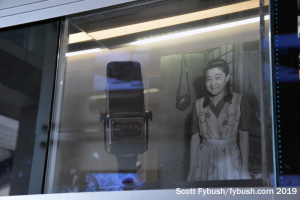

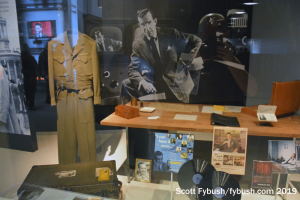

Another level down, there was a small but valuable gallery dedicated specifically to broadcast journalism. A John Cameron Swayze board game? That was here – and so was Edward R. Murrow’s wartime wardrobe and the actual microphone used by Iva Toguri, aka “Tokyo Rose,” complete with the mic flag from JOAK radio in Tokyo.
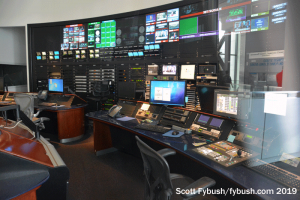

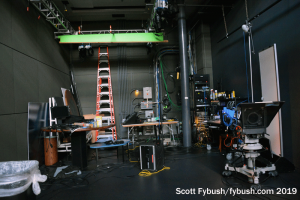

One of the big plans for the Newseum when it moved from Virginia to DC in 2008 was to become an origination point for live broadcasts, and so there were two TV studios on the middle floors of the building: a larger one that could feature panel discussions and hold audiences, plus a smaller one designed specifically around a window that looked to the southeast with a dynamite view of the Capitol building a few blocks away.
For a few years, ABC made active use of one of the studios to originate its Sunday morning “This Week” show here, but by the end of 2019 the studios and their accompanying control room had become largely a museum exhibit, where docents showed off the technology of TV production to visitors. (You could also stand in front of a green screen in another gallery and pretend to be a TV reporter; having already done that for a few years in real life, your editor was happy to leave that fun to the kid who came along on the trip.)
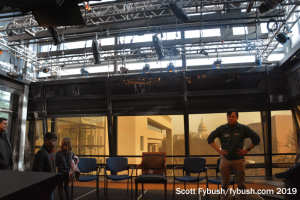

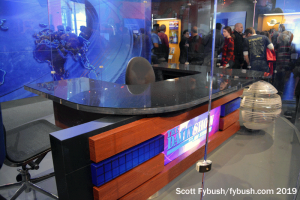

More fun on the lower levels, at least when we visited, included a gallery showing off artifacts from Comedy Central’s Daily Show, including the desk that Jon Stewart used in his final years as host.
And there was more serious business happening lower on the museum floors, too, including exhibits on media censorship around the world and a memorial to journalists killed in the line of duty. On the ground floor, we had just enough time to speed through the exhibit on the history of Pulitzer Prize-winning news photography before closing time, when we said our sad farewells to this museum just 48 hours before it was to shut its doors for good.
The building was sold to Johns Hopkins University, whose plans to make it a center for its DC activities have been slowed by the pandemic. The First Amendment just came off the facade a few weeks ago. Many of the Newseum exhibits that had been on loan have been returned to their owners, while the artifacts owned by the museum itself are in storage, awaiting (we hope) the Freedom Forum’s decision on a new site for a scaled-down third incarnation of the Newseum.
Visit what’s left of the Newseum, including previous special exhibits, online
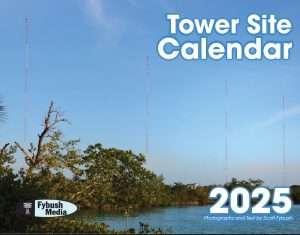
Behold, the 2025 calendar!
We chose the 100,000-watt transmitter of the Voice Of America in Marathon, right in the heart of the Florida Keys. This picture has everything we like in our covers — blue skies, greenery, water, and of course, towers! The history behind this site is a draw, too.
Other months feature some of our favorite images from years past, including some Canadian stations and several stations celebrating their centennials (can you guess? you don’t have to if you buy the calendar!).
We will ship daily through Christmas Eve. Place your order now for immediate shipping!
This will be the 24th edition of the world-famous Tower Site Calendar, and your support will determine whether it will be the final edition.
It’s been a complicated few years here, and as we finish up production of the new edition, we’re considering the future of this staple of radio walls everywhere as we evaluate our workload going forward.
The proceeds from the calendar help sustain the reporting that we do on the broadcast industry here at Fybush Media, so your purchases matter a lot to us here – and if that matters to you, now’s the time to show that support with an order of the new Tower Site Calendar. (And we have the new Broadcast Historian’s Calendar for 2025 ready to ship, too. Why not order both?)
Visit the Fybush Media Store and place your order now for the next calendar, get a great discount on previous calendars, and check out our selection of books and videos, too!
And don’t miss a big batch of DC IDs next Wednesday, over at our sister site, TopHour.com!
Next week: Some Sites Around Western New York
In this week’s issue… WKIT finds a buyer - Eskin out at WIP - Staff shifts in Utica - CRTC approves Bell divestitures
In this week’s issue… WBUR backs off local talk - EMF's expansion in NY, nationally - Rochester broadcasters honored - Russell finds new PA radio home - Remembering Bruce Stevens - The new calendar's here!
In this week’s issue… Remembering WNY's Palvino, Harris - Will King sell Bangor stations? - Kay moves earlier - New signal on LI - Cumulus cuts hit PA, New England - Frizzell sells in NH
In this week’s issue… Saluting a small-town radio vet - Bell moves CP24 - Scott heads west - Burlington gets Air 1, "Experimental Radio" - Family Life heads down I-86